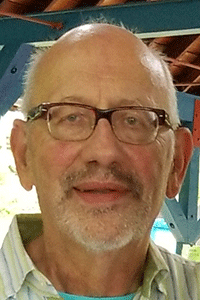The Challenge: A Family History of Heart Disease
George Stout knows firsthand the gravity of cardiovascular issues.
“My father and all of his siblings died before the age of 50 from heart problems. My mother died at age 70 from heart problems. I knew it was something I was predisposed to,” George explains.
The 71-year-old West Newton resident knew his chances of facing cardiovascular problems were great. What he didn’t know was the life-changing opportunity he'd receive at UPMC.
George’s own heart issues began 27 years ago. While in Wheeling, W. Va., the then 45-year-old George recognized he was having a heart attack. Luckily, he was close to the nearest hospital and could drive himself there.
Once admitted to the Emergency Department, doctors diagnosed George with a proximal left anterior descending (LAD) lesion, commonly known as the “Widowmaker.”
They stabilized George and gave him a tissue plasminogen activator (tPA).
tPA is a drug that helps dissolve coronary blood clots, often aiding in the survival of heart attacks. Doctors administer intravenously through a catheter inserted in a vein in the arm.
The Path to UPMC from an Emergency Room in West Virginia
The ER doctors in West Virginia transferred George to Pittsburgh where he first met his cardiologist, Bryan C. Donohue, MD.
“Dr. Donohue and I just clicked. I trusted him and his decisions for my health.”
George understood the importance of a good relationship with your doctor.
“I always felt confident that he had my best interests in mind,” George said.
Over the years, George’s heart issues persisted.
“I suffered 3 to 4 subsequent heart attacks. I had a bypass procedure and probably every other procedure or test possible over the years at UPMC,” George explains.
Eventually, in 2017, doctors diagnosed George with heart failure and AFib.
AFib occurs when the upper chamber of the heart beats irregularly, causing ineffective pumping of blood. Although not life-threatening, AFib can increase the risk of blood clots, stroke, and other heart-related problems.
This diagnosis was, in George’s eyes, the final blow.
“I didn’t think there was anything else the doctors could do,” George states.
The Solution: Heart Transplant
However, Dr. Donohue wasn’t ready to give up.
With George in the hospital at UPMC Presbyterian, Dr. Donohue reached out to the advanced heart failure team. A member of the team visited George in his hospital room and conducted a patient interview.
Later, the rest of the cardiology and heart surgery team gave George and his wife a more in-depth interview.
At UPMC, there is no upper age limit for heart transplants.
The care teams assess the risks and benefits of heart transplant for each patient. They make a decision on a case by case basis, based on a variety of factors, including age and comorbidities.
After these interviews, the team placed George on the heart transplant waiting list. A mere 22 days later, on April 2, 2017, George got the call. They had a heart waiting for him.
“This new heart changed my life,” George exclaims.
The Results: A New Heart and New Lease on Life
Taking part in the cardiac rehab program at UPMC Shadyside was a major factor in George’s speedy recovery.
“I couldn’t have lived without the cardiac rehabilitation program. I did everything the doctors told me to do, and it made all the difference,” said George.
The months of rehab and recovery went quickly. Before George knew it, he was back to doing things he hadn’t been able to do for years.
“I was able to resume my business. I hadn’t been able to work the past two years because of my heart issues. Now I’m back, and it’s great.”
Part of being back to work in the furniture business means resuming his work trips. George travels to North Carolina regularly to check on his furniture showroom in Highpoint and attend the furniture market twice a year.
At 71 years old, George is extremely grateful for his new heart and the new lease on life it has given him. He recognizes how fortunate he is.
“I understand that not many people are given a new heart at the age of 71. I felt so fortunate to have been on the transplant waiting list for only 22 days. And to have received a new heart at my age,” George said.
George also recognizes the hard work and dedication of the cardiovascular team at UPMC.
“All of those doctors were so great. Everyone I encountered. I just love them all!”
While George was aware of his family history of heart problems, he didn't receive testing or screening before his first heart attack. However, he became determined not to allow his adult sons to go through the same ordeals he went through.
“I made sure my sons went to the doctors and were screened. They now work with their doctors to monitor their hearts more closely. And hopefully, they will be able to avoid going through what I did,” George explains.
These days, George and his wife are enjoying their time together.
Avid shag dancers, the duo goes dancing every week, as they did throughout the entirety of George’s heart problems.
“I truly believe that our weekly dancing helped keep me going for as long as I did. I’m so happy we can continue to go. Life is good,” George laughs.
George's treatment and results may not be representative of similar cases.
Read more heart transplant patient stories
Learn More About Heart Attack and Heart Health
From the UPMC HealthBeat Blog:
From the UPMC Health Library:
















